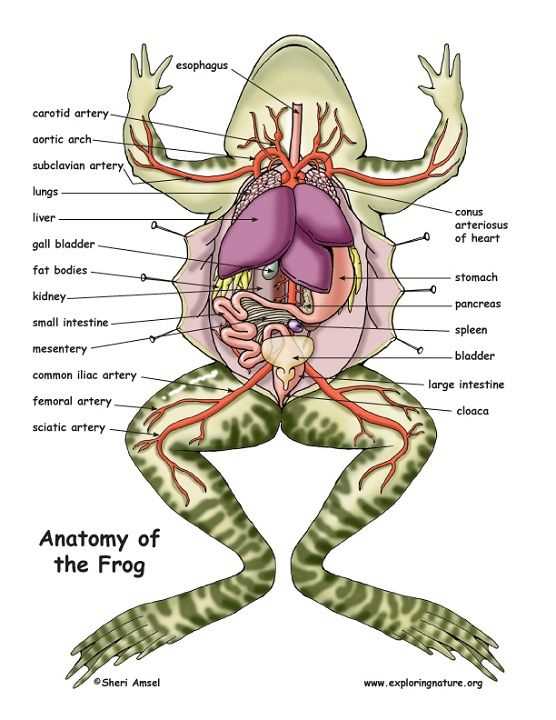Frogs are fascinating creatures with unique adaptations that allow them to survive in a wide range of environments. One of these adaptations is their fat bodies, which play a crucial role in their physiology. Fat bodies in frogs serve multiple functions, including energy storage, hormone production, and immunity support.
One of the primary functions of fat bodies in frogs is energy storage. Just like in other animals, fat bodies in frogs store excess energy in the form of lipids. These lipids can be used as a source of fuel during times of low food availability or hibernation. The fat bodies also help frogs regulate their body temperature by providing insulation against heat loss.
Fat bodies in frogs also have an important role in hormone production. They produce hormones that regulate various physiological processes, including metabolism, growth, and reproduction. These hormones are essential for maintaining the overall health and well-being of the frog.
In addition to energy storage and hormone production, fat bodies in frogs also play a vital role in supporting the immune system. They contain immune cells that help defend the frog against pathogens and diseases. The immune cells in the fat bodies produce antibodies and other molecules that can neutralize or kill harmful microorganisms.
The Role of Fat Bodies in a Frog’s Physiology

The function of frog fat bodies is primarily related to energy storage and release. Fat is an excellent energy reserve as it contains more than twice the amount of energy per gram compared to proteins or carbohydrates. During periods of abundant food availability, frogs accumulate fat in their fat bodies, which can be utilized during times of scarcity.
In addition to their role in energy metabolism, frog fat bodies also serve as an essential site for hormone production. They produce various hormones that regulate metabolism, growth, and reproduction. These hormones are released into the bloodstream and have widespread effects on different physiological processes in the frog’s body.
Frog fat bodies are highly dynamic structures. Their size and composition can change rapidly in response to environmental conditions and the frog’s metabolic state. For example, during the breeding season, male frogs undergo significant changes in their fat bodies to support the production of sperm and the energetic demands of courtship and mating.
The importance of frog fat bodies in metabolism is further highlighted by their involvement in temperature regulation. Fat bodies act as insulation, helping frogs maintain optimal body temperature in different environmental conditions. This is particularly critical for ectothermic animals like frogs, whose body temperature is influenced by the temperature of their surroundings.
Importance of Frog Fat Bodies in Metabolism
Frog fat bodies play a crucial role in the metabolism of these amphibians. These specialized structures, located in the abdominal cavity, are responsible for storing and releasing energy, as well as participating in various metabolic processes.
Energy Storage: Frog fat bodies serve as a primary storage site for energy in the form of lipids. This allows frogs to survive during periods of food scarcity or in environments where food resources are limited. The fat bodies accumulate and store lipids in adipocytes, which can be broken down and used as a source of energy when needed.
Energy Release: During times of increased activity or when food is scarce, frog fat bodies release stored lipids to provide the necessary energy. This energy release is essential for maintaining vital bodily functions and supporting the frog’s overall metabolic needs.
Metabolic Processes: Frog fat bodies are involved in various metabolic processes, including hormone production. They produce hormones such as leptin and adiponectin, which play important roles in regulating energy balance, appetite, and metabolism. These hormones help coordinate and control the utilization of energy from stored lipids, ensuring efficient energy utilization in frogs.
Adaptation to Environmental Conditions: Frog fat bodies also adapt to different environmental conditions. For example, in cold environments, fat bodies may increase in size to provide insulation and maintain the frog’s body temperature. In contrast, during periods of hibernation or aestivation, fat bodies may decrease in size as energy requirements are reduced.
The Function of Frog Fat Bodies in Physiology
Storage of Lipids
One of the main functions of frog fat bodies is to store lipids, which serve as an important source of energy. Frogs, being ectothermic animals, rely on external sources of heat to regulate their body temperature. During periods of inactivity or hibernation, when food is scarce, fat bodies serve as a reservoir of energy that can be utilized to sustain the frog’s metabolic needs.
Fat bodies are composed of adipocytes, specialized cells that are capable of storing large amounts of lipids. These lipids are stored in the form of triglycerides, which can be broken down and metabolized to release energy when needed. The ability to store lipids allows frogs to survive in environments with fluctuating food availability.
Hormone Production

Estrogen, for example, is essential for the development and functioning of the reproductive organs in female frogs. It helps regulate the menstrual cycle and promotes the growth of eggs. Progesterone, on the other hand, is involved in preparing the female frog’s reproductive tract for egg fertilization and pregnancy.
In addition to reproductive hormones, fat bodies also produce hormones that regulate metabolism and energy balance. These hormones, such as leptin and adiponectin, help regulate food intake, energy expenditure, and fat storage. They play a crucial role in maintaining energy homeostasis in frogs.
Ener”>
The main function of frog fat bodies is to store excess energy in the form of lipids. When frogs consume food, their bodies convert the nutrients into lipids, which are then deposited in the fat bodies for future use. This energy storage is critical for the frog’s survival, especially during periods of limited food availability, such as winter hibernation or drought.
When the frog’s body requires energy, such as during periods of activity or reproduction, the fat bodies release stored lipids back into the bloodstream. These lipids are broken down into fatty acids, which can be utilized as a source of energy by the frog’s muscles and organs. This energy release is crucial for various physiological processes, including locomotion, metabolism, and maintaining body temperature.
The importance of the frog’s fat bodies in energy metabolism cannot be overstated.
Aside from energy storage and release, frog fat bodies also play a role in hormone production. These fat cells contain hormone receptors and enzymes that are involved in the synthesis and metabolism of hormones, such as leptin and adiponectin. These hormones play crucial roles in regulating metabolism, appetite, and energy balance in frogs, similar to their roles in mammals.
Frog fat bodies are not only involved in energy metabolism but also in reproduction. During the breeding season, the fat bodies undergo significant changes to support reproduction. They act as a source of nutrients for egg development and provide energy for the male frogs during the mating process. Additionally, the fat bodies produce reproductive hormones that regulate mating behaviors and facilitate successful reproduction.
The Role of Frog Fat Bodies in Reproduction
Frog fat bodies play a crucial role in the reproductive function of these amphibians. These specialized organs serve as a source of energy and nutrients during reproduction.
During the breeding season, frogs allocate a significant amount of energy towards reproductive processes, such as gonad development, egg production, and courtship behaviors. Fat bodies play a vital role in providing the necessary energy for these activities.
One of the main functions of frog fat bodies in reproduction is the production and storage of lipids, which are essential for the development and maturation of eggs. Lipids serve as a rich source of energy for the growing embryos. The fat bodies also secrete hormones that regulate reproductive processes such as ovulation and the timing of breeding activities.
In addition to providing energy and nutrients, frog fat bodies also contribute to the overall reproductive success of these amphibians. Fat bodies release various substances, including pheromones, which play a crucial role in attracting mates and enhancing the chances of successful reproduction.
Furthermore, fat bodies in female frogs undergo significant changes throughout the reproductive cycle. They accumulate lipid reserves during periods of food abundance, which are then utilized during egg development and spawning. These lipid reserves ensure that female frogs have sufficient energy to produce and lay their eggs.
The size and composition of frog fat bodies can vary depending on factors such as species, age, and environmental conditions. For example, frogs living in harsh environments with limited food resources may have smaller fat bodies and allocate less energy towards reproduction compared to those in more favorable conditions.
Impact of Environmental Factors on Frog Fat Bodies
The fat bodies in frogs play a crucial role in their physiology, and they are highly influenced by various environmental factors. These factors can have both positive and negative effects on the fat bodies of frogs.
Temperature
Food Availability
The availability and abundance of food in the environment can also affect frog fat bodies. When food is scarce, frogs may start utilizing the stored fat as an energy source for survival. This can lead to a reduction in fat body size and overall energy stores. Conversely, in environments with abundant food resources, frogs can accumulate more fat, which can be utilized during times of scarcity.
Habitat Quality
The quality of the habitat can have a significant impact on frog fat bodies. Pollution, deforestation, and habitat destruction can disrupt the natural balance and availability of resources, leading to changes in fat body size and function. In polluted environments, the accumulation of toxins in the frog’s fat bodies can impair their metabolic processes and overall health. Furthermore, the loss of suitable habitats due to deforestation can result in decreased food availability and increased energy expenditure for mobility, both of which can negatively affect the fat body reserves of frogs.
Conclusion

I’m Lena Adams—a product of an unconventional upbringing in the African wilderness. My father, a daring explorer of African wildlife, sparked my fascination with reptiles, a passion that intertwined with the tragic loss of my mother during an expedition, leaving an indelible mark on my life. Driven to understand the creatures that captivated my parents, I embarked on my journey, sharing insights about reptiles, frogs, and lizards on my website. Through my explorations and conservation efforts, I honour my family’s legacy while seeking connections—to the creatures, nature, and the mother whose presence I yearn to understand.
